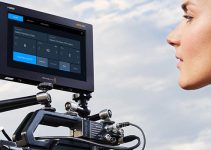Besides, the Super 35mm-sized sensor that both Blackmagic Production Camera 4K and the URSA camera share, today they have another feature in common – in-camera formatting. Recently, Blackmagic Design have announced two new firmware updates.
Camera Utility 1.9.5 finally adds in-camera SSD formatting for the BMPC 4K, which will be ported on other cameras soon, while Camera Utility 1.9.4 released yesterday adds “general performance improvements” on the URSA.
We hope given the recent firmware updates and new footage, that the camera will be actually shipping soon. There are only a couple of videos with demo footage, the one produced by the Australian-based cinematographer John Brawley, released in the first place, and another short video recently spotted on Vimeo produced by the US-based photographers Danelle and Hook.
It is obvious that, intentionally or not, shipping the camera in July was unofficially “delayed” again by Blackmagic Design. It wasn’t surprising the July shipping announcement about the URSA they made at NAB in April, was met with quiet skepticism by some. It wasn’t a secret to many that the URSA wouldn’t be finished by July. However, we need to give them credit where credit is due, as the slow-motion footage from the camera is quite impressive.
The Bear in NZ Winter – Beta URSA Footage from A Couple Of Night Owls on Vimeo.
The video was mostly shot at 60fps Prores 422HQ in camera and conformed to 24fps. This is the maximum speed the URSA could shoot at the moment which is not very impressive for camera with the ergonomics and size of the ALEXA, though. Should we ask for more from a $6,000 camera some of you may ask? Probably not, but just saying we hope to see higher frame rates in the future.
Yet, the URSA features 4K Super 35mm global shutter sensor with 12 stops of dynamic range, a built-in 10.1″ 1920 x 1200 fold out display, interchangeable sensor and lenses, UHD and HD RAW and ProRes recording to CFast cards, industry-standard professional XLR audio inputs and a real camera form factor, at last but not least. In combination with the proper audio leveling meters, zebras, histogram, time remaining display and ability to format cards in-camera the URSA will be a great option for many filmmakers and small production houses that work on a budget as well.
Furthermore, according to the SEO of Blackmagic Design Grant Petty, the hardware of the URSA camera is actually capable of recording in higher rates than 60 frames per second and the feature could be enabled with some additional minor hardware tweaks. This probably would make the URSA even more attractive as recently there is enough competition on camera market by the other manufacturers such as Sony and Panasonic in particular.
Here is the other video, this time from John Brawley, in case you’ve missed it:
URSA does Bronte from John Brawley Tests on Vimeo.
The URSA camera will be availabe in four options Blackmagic URSA EF, Blackmagic URSA PL, Blackmagic URSA Broadcast, Blackmagic URSA HDMI, with the Broadcast having a totally different sensor, and the HDMI-only model which has no sensor and is basically used as a recorder.
Disclaimer: As an Amazon Associate partner and participant in B&H and Adorama Affiliate programmes, we earn a small comission from each purchase made through the affiliate links listed above at no additional cost to you.
Claim your copy of DAVINCI RESOLVE - SIMPLIFIED COURSE with 50% off! Get Instant Access!



